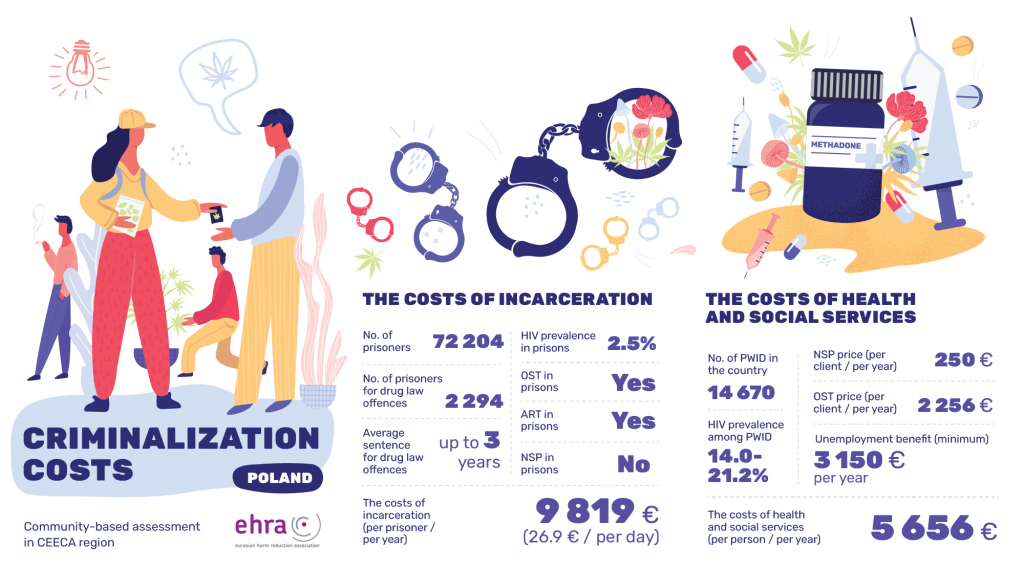As of 2019, there were 72,204 people imprisoned in Poland, of which 2,294 were sentenced for drug law offences [1]. Possession of small amounts of illicit drugs carries a penalty of up to three years imprisonment and possession of significant amounts can result in incarceration for up to 10 years [2]. However, roughly 90% of people sentenced for simple possession get a suspended sentence, usually 1 year but suspended for 3 years [3]. HIV prevalence among prisoners was estimated in 2017 at 2.5% [4]. Antiretroviral therapy (ART) is reportedly available in prisons as is opioid substitution therapy (OST) but not needle/syringe programmes (NSP) [5].
The Government of Poland spends €9,819 per year to support each person in prison, or €26.90 per day [6].
There were estimated to be 14,670 people who inject drugs in Poland in 2019, with an HIV prevalence of between 14.0% and 21.2% [7]. The costs of NSP services in 2018 were in the region of €250 per client, per year, and that of OST in 2020 around €2,256 per client, per year [8]. The unemployment benefit is €3,150 per person, per year, or €262.50 per month [9].
Therefore, it would cost the Government of Poland €5,656 per person, per year, if it were to pay the costs of assisting a person who injects opioids in community settings. This is €4,163 less than the cost of keeping that person in prison each year. Consequently, the Government of Poland could save up to €9.5 million in total each year if it decriminalised drug use and possession.
[1] Aebi MF, Tiago MM. SPACE I – 2019 – Council of Europe Annual Penal Statistics: Prison populations. Strasbourg; Council of Europe, 2020. https://wp.unil.ch/space/files/2021/02/200405_FinalReport_SPACE_I_2019.pdf (accessed 4 August 2021).
[2] Criminal Law/Karne. Practical guide: Possession of a narcotic or psychotropic substances. Warsaw; Karne.pl, 2017. http://karne.pl/en/possession-drugs.html (accessed 9 August 2021).
[3] Information submitted by national partners.
[4] Joint United Nations Programme on HIV and AIDS (UNAIDS). The Key Populations Atlas. Geneva; UNAIDS. https://kpatlas.unaids.org/dashboard (accessed 3 August 2021).
[5] Harm Reduction International (HRI). Global State of Harm Reduction 2020, Regional Overview 2.2 Eurasia. London; HRI, 2021. https://www.hri.global/files/2020/10/26/Global_State_HRI_2020_2_2_Eurasia_FA_WEB.pdf (accessed 3 August 2021).
[6] Aebi M F, Tiago MM. SPACE I – 2020 – Council of Europe Annual Penal Statistics: Prison populations. Strasbourg; Council of Europe, 2021. https://wp.unil.ch/space/files/2021/04/210330_FinalReport_SPACE_I_2020.pdf (accessed 3 August 2021).
[7] European Monitoring Centre for Drugs and Drug Addiction (EMCDDA). Poland Country Drug Report 2019. Luxembourg; Publications Office of the European Union, 2019. https://www.emcdda.europa.eu/system/files/publications/11349/poland-cdr-2019_0.pdf (accessed 9 August 2021).
[8] Information submitted by national partners.
[9] First News. Unemployment benefit to rise to EUR 262.9 a month plus bonus – PM. Warsaw; Polish Press Agency, 15 May 2020. https://www.thefirstnews.com/article/unemployment-benefit-to-rise-to-eur-2629-a-month-plus-bonus—pm-12722 (accessed 9 August 2021).

